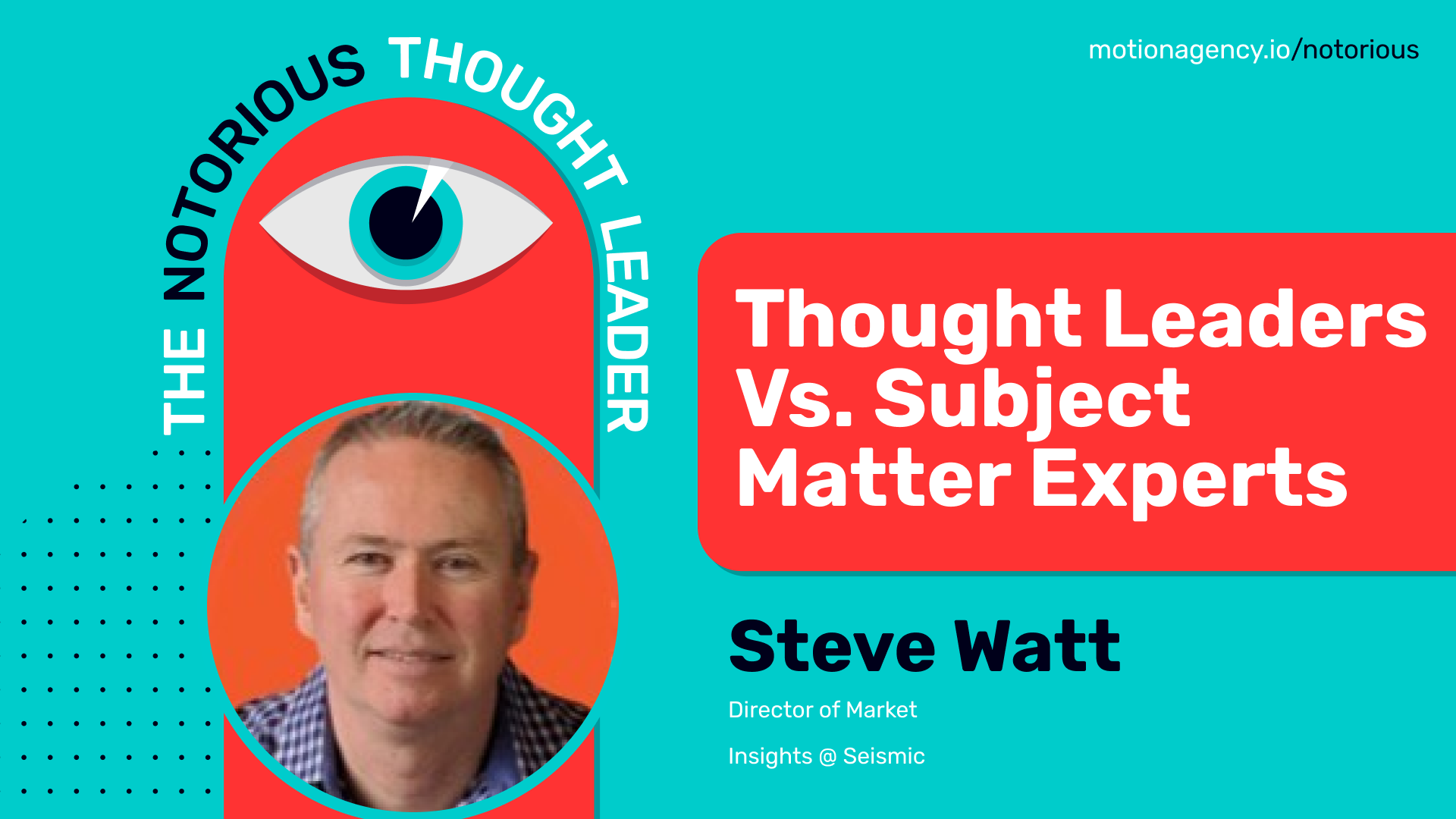Episode Summary
In B2B marketing, we constantly see buzzwords fly around. And it seems as soon as a term brings value to marketing, it gets overused and outdated.
But what does that mean for the term “thought leadership”? How does this term play a role in marketing right now?
Steve Watt, the Director of Market Insights at Seismic, is our guest on this episode of The Notorious Thought Leader. Steve discusses what thought leadership is not and the difference between a thought leader and a subject matter expert. Steve also explains how companies and their employees can be thought leaders and what businesses should do to encourage their team members to pursue it. Finally, he shares what high-quality content is and the types of formats he mainly creates for LinkedIn.
Guest Profile

- Name: Steve Watt
- What Steve does: Steve is the director of Market Insights at Seismic.
- Company: Seismic
- Noteworthy: Steve helps Seismic customers in financial services, professional services, and B2B technology build high-impact buyer-centric social selling and client-centric employee advocacy programs. He is also a public speaker and a writer and is challenging ''sales, marketing, and enablement leaders to cast aside old mindsets and approaches to social and build something entirely different and much more impactful.''
Key Insights
- We can define thought leadership by explaining what it is not. Such an approach allows for a new perspective and an opportunity to get to the bottom of authentic thought leadership. So, when we asked Steve what characterizes a thought leader, he suggested that we first establish what does not. '''Here's why you should buy my product.' That's not thought leadership. That's promotions, marketing, and copywriting. There's been a bit of dumbing down of what thought leadership is in the broad sense. Like, everybody's a thought leader, but so much of what you see out there is basically, 'Here's why you should buy my product.'''
- Both a company and its team members can be thought leaders. However, it is critical for anyone aspiring to become a brand advocate and a thought leader to not copy-paste what the company is doing in this case. Instead, everyone should be allowed to develop unique methods. ''At Seismic, we're focused on sales enablement and enablement right from training and onboarding of salespeople and other client-facing people right through the delivery of what they do, the measurement of what they do, and their advancing careers and success. We as a company ought to be a corporate thought leader in how to do that better. But there's room under that umbrella for people like me. I'm a subject matter expert today, but I aspire to be more of a thought leader. But I'm not going to try to duplicate the company's thing. I'm focused on one slice of it — social selling and employee advocacy — which is only one small part of what my company cares about, but I'm digging in deep to be the expert in that piece.''
- Creating high-quality content requires balance. So even if you see a higher engagement of one type of content, like videos or memes, you can't solely rely on those. It's better to create various formats to provide value. And, of course, adjust it to your style and audience. In other words, ''It's like a balanced diet. And to eat a balanced diet does not mean that every day or every week, I eat this perfectly partitioned amount of protein, healthy carbs, and healthy fats and allow myself this many desserts. That's not eating a balanced diet. It flexes; it flows. But if you find yourself eating a lot of junk food and very little healthy food, you're not doing it right. So I give myself permission to flex and flow depending on what I feel like. I don't want to be rigid about it and say, 'I'm gonna post six times a week, and three of them are gonna be this, and two are gonna be that.' That's too rigid for me.''
Episode Highlights
We’re Scaring People off of the Term ‘Thought Leader’ and Cheapening It
“If everyone is or can be a thought leader, we need a new term. I don’t believe everyone is or wants to be a thought leader. A thought leader creates new maps, but there are a whole lot of expedition leaders who follow existing maps; that’s critical. […]
We do thought leadership a disservice, and we do people a disservice, when we say everyone’s a thought leader, everyone ought to be a thought leader, or everyone can be a thought leader. I prefer to look at it as everyone can and ought to be a subject matter expert.
Everyone ought to publicly demonstrate subject matter expertise and passion for what they do,who they do it for, and why it matters. And to me, that is something that we should all embrace and not intimidate people with this idea, like, ‘Oh, you’ve gotta go further and become a thought leader.'”
To Encourage Employees to Be Active on LinkedIn, Lead by Example
”It’s tough. Also, you can’t force it. If you’re out there mandating that people be active on LinkedIn, that’s like culture damage. They’re not going to do it or do it poorly to get you off their back.
So it has to be all education, inspiration, encouragement, and leading by example. One of the most critical things missing in a lot of firms is if you want your people to be active on LinkedIn, you need executive leadership. That does not mean that every one of your senior executives needs to be active because that’s never going to happen. But you need a few of them. […]
There are a lot of people who are fearful of being active on LinkedIn because they’re stuck in old mindsets. And the most critical old mindset is that LinkedIn is a place you go to for a new job.
You need senior executives very clearly saying, ‘Look, LinkedIn is not just a job board. LinkedIn is a giant business forum now. And to the extent that you are comfortable getting out there and showing up and speaking up, we welcome it; we support it; we respect it.”’
It’s Not Always About Likes and Comments; Silent Support Can Lead to Unexpected Yet Significant Outcomes
”Last week, I was in San Diego. We had a huge Seismic customer event. We had about 800 of our customers, plus a couple hundred of our people.
I couldn’t tell you how many times a customer stopped me in the halls or at social events like, ‘Steve, I love your posts. I’ve been reading them.’ In many cases, they were not familiar names or faces. They have not been engaging, but they’ve been noticing and knew who I was and lit up when they saw me. And that’s an amazing thing.
And I’ll tell you one other story. This one’s from a few years ago, before I was at Seismic, and a CMO told me that her CEO was 71 years old, did not use LinkedIn, and didn’t even like to use computers. So she printed off my posts on paper and put them on his desk. They ended up becoming a client of mine at the time because he loved what he was reading.
So if you’re out here thinking it’s all about likes, public comments, and stuff, you’re missing the bulk of the iceberg. You are building a reputation in relationships and credibility and trust in ways that are hard to see at times and hard to measure, but they’re real.”

